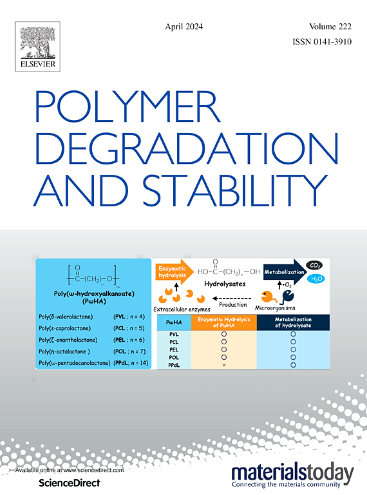Innovative development of green nitrogen-phosphorus-based flame retardant for enhancing fire safety of cotton fabrics
IF 6.3
2区 化学
Q1 POLYMER SCIENCE
引用次数: 0
Abstract
This study presents the synthesis and application of a novel green nitrogen-phosphorus flame retardant, ammonium salt of neopentyl glycol phosphate acid (ASNGPA), for cotton fabrics to enhance their fire resistance. ASNGPA was developed utilizing neopentyl glycol, phosphoric acid, and urea as the primary raw materials, which resulted in the formation of target product containing the active group -O-P(=O) -(ONH4+)2. Subsequently, fire-retardant fabric could be achieved by grafting ASNGPA onto the fabrics through forming -O-P(=O)-O-C- bonds in dipping and high-temperature process. Structural characterization by nuclear magnetism resonance (NMR), Fourier transform infrared spectroscopy test (FT-IR), and X-ray diffraction (XRD), as well as scanning electron microscope (SEM) and energy dispersive spectroscopy (EDS), confirmed the chemical structure and elemental composition of ASNGPA and ASNGPA-treated fabrics. Thermal stability tests indicated the improved thermal behavior, delayed onset of decomposition and reduced weight loss rates of samples during heating. The comprehensive assessment of fabric's flame retardancy through vertical flame vest, limiting oxygen index (LOI) measurements, and cone calorimetry has significantly demonstrated the enhanced fire resistance properties. The LOI values of the samples with 10 %, 20 % and 30 % concentration are all above 40 % while ASNGPA-treated fabrics exhibited reduced heat and smoke release velocities when compared to their untreated cotton counterparts. Furthermore, ASNGPA-treated fabrics preserved their satisfactory durability even after numerous washing cycles. The eco-friendliness of ASNGPA lies in its formaldehyde-free synthesis process and the absence of harmful halogenated gases produced during combustion, despite slight modifications in its mechanical properties. The research on this new nitrogen-phosphorus flame retardants would enhance the flame retardancy of materials. By integrating the advantages of nitrogen and phosphorus, it could reduce fire risks while mitigating environmental pollution, aligning with the trend of green development.

创新开发提高棉织物防火安全性的氮磷基绿色阻燃剂
研究了新型绿色氮磷阻燃剂新戊二醇磷酸铵盐(ASNGPA)的合成及应用,以提高棉织物的防火性能。以新戊二醇、磷酸和尿素为主要原料制备ASNGPA,得到含有活性基团-O- p (=O) -(ONH4+)2的目标产物。随后,在浸渍和高温过程中,通过形成-O- p (=O)-O- c -键,将ASNGPA接枝到织物上,得到阻燃织物。通过核磁共振(NMR)、傅里叶变换红外光谱(FT-IR)、x射线衍射(XRD)、扫描电镜(SEM)和能谱(EDS)对ASNGPA及其处理织物进行了结构表征,确定了其化学结构和元素组成。热稳定性测试表明,在加热过程中,样品的热行为得到改善,分解延迟,失重率降低。通过垂直火焰背心、极限氧指数(LOI)测量和锥量热法对织物的阻燃性进行了综合评价,结果表明织物的阻燃性能得到了显著提高。浓度为10%、20%和30%的样品LOI值均在40%以上,而经过asngpa处理的织物与未经处理的棉织物相比,热和烟雾释放速度降低。此外,经过asngpa处理的织物即使经过多次洗涤也能保持令人满意的耐用性。ASNGPA的环保性在于其合成过程中不含甲醛,燃烧过程中不产生有害的卤化气体,但其机械性能略有改变。这种新型氮磷阻燃剂的研究将提高材料的阻燃性能。结合氮磷的优势,在降低火灾风险的同时减轻环境污染,顺应绿色发展的趋势。
本文章由计算机程序翻译,如有差异,请以英文原文为准。
求助全文
约1分钟内获得全文
求助全文
来源期刊

Polymer Degradation and Stability
化学-高分子科学
CiteScore
10.10
自引率
10.20%
发文量
325
审稿时长
23 days
期刊介绍:
Polymer Degradation and Stability deals with the degradation reactions and their control which are a major preoccupation of practitioners of the many and diverse aspects of modern polymer technology.
Deteriorative reactions occur during processing, when polymers are subjected to heat, oxygen and mechanical stress, and during the useful life of the materials when oxygen and sunlight are the most important degradative agencies. In more specialised applications, degradation may be induced by high energy radiation, ozone, atmospheric pollutants, mechanical stress, biological action, hydrolysis and many other influences. The mechanisms of these reactions and stabilisation processes must be understood if the technology and application of polymers are to continue to advance. The reporting of investigations of this kind is therefore a major function of this journal.
However there are also new developments in polymer technology in which degradation processes find positive applications. For example, photodegradable plastics are now available, the recycling of polymeric products will become increasingly important, degradation and combustion studies are involved in the definition of the fire hazards which are associated with polymeric materials and the microelectronics industry is vitally dependent upon polymer degradation in the manufacture of its circuitry. Polymer properties may also be improved by processes like curing and grafting, the chemistry of which can be closely related to that which causes physical deterioration in other circumstances.
 求助内容:
求助内容: 应助结果提醒方式:
应助结果提醒方式:


